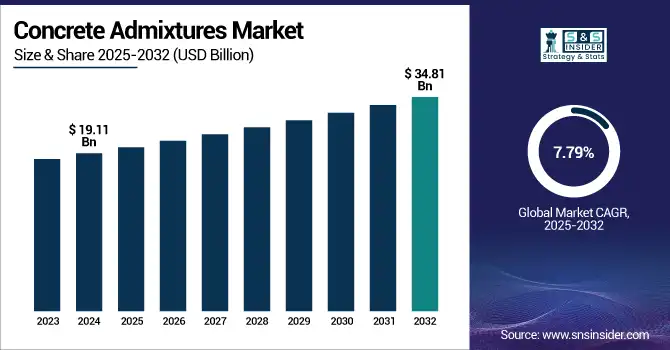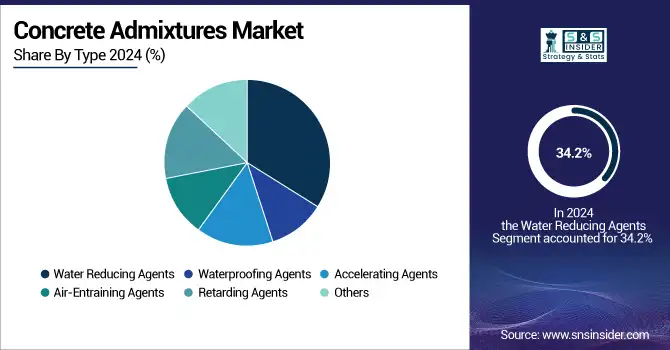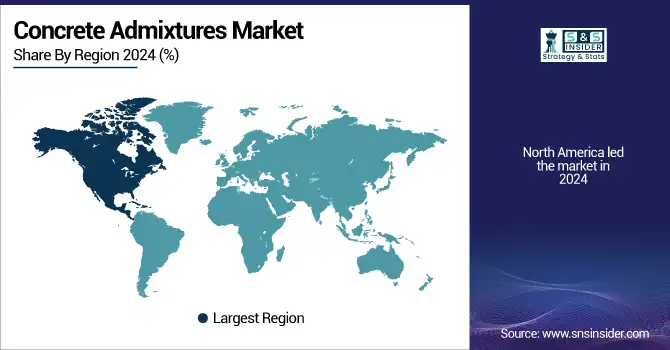Concrete Admixtures Market Report Scope & Overview:
The Concrete Admixtures Market size was valued at USD 19.11 billion in 2024 and is expected to reach USD 34.81 billion by 2032, growing at a CAGR of 7.79% over the forecast period of 2025-2032.

To Get more information on Concrete Admixtures Market - Request Free Sample Report
The growth of the concrete admixtures market is driven by urbanization, infrastructure investments, and ongoing innovations in admixture technologies. Some of the trends in the ready-mix concrete admixtures market will be the use of self-compacting mixtures and the use of digital solutions for the optimization of mixtures. Other trends among the companies operating in the market include sustainability through low-carbon admixtures and advancements in digital analytics to optimize mix performance. These trends drive concrete admixtures market growth, for instance, rapid-setting and anti-corrosive admixtures have gained acceptance for bridge decks and marine structures.
Construction industry data published by the U.S. Geological Survey placed cement consumption in America at 120 million tonnes this year. Similarly, Mapei S.p.A. also witnessed revenue growth of 5.2% in the Concrete Admixtures in fiscal 2023 due to the acquisition of a Danish facility, indicating the increased demand for high-performance concrete solutions.
Concrete Admixtures Market Dynamics
Drivers
-
Rising Government Infrastructure Investments And Construction Projects Boosts The Market Growth
Construction activity is propelled by heavy infrastructure expenditure and urban development in many markets. Increased government funding for highways, bridges and utilities has resulted in high-strength concrete demand. Large scale projects in Asia-Pacific (high-speed rail, urban transit) also pave way for admixture consumption. As Admixtures provide higher workability & strength and lower setting time for concrete, larger quantities of concrete, in turn, lead to larger volumes of concrete admixtures market. Many of these projects call for high performance admixtures for rapid curing and to lower cement use and meet sustainability objectives. As a result, demand is driving industry leaders to expand capacity.
-
Growing emphasis On Sustainable, Low-Carbon Concrete Solutions Propel the Market Expansion
The use of green concrete technology is being driven by sustainability goals. In an effort to reduce carbon footprint, regulators and builders are turning more to supplementary cementitious materials (flyash, slag), and to additives that capture recycled content. In 2023, USGS stated that 97% of all new blended cement shipments were low-carbon portland-limestone (PLC) cement, resulting in an increased need for admixture use for equal strength. Alternative fuels and recycled materials are gaining acceptance in the cement industry, and green procurement and research incentives are backing decarbonization from the governmental side. Green building standards (e.g. LEED) provide an additional reward for the more sustainable mixes. Concrete admixtures companies saw this opportunity and are now developing new low-VOC, high-performance formulations for those applications. Collectively, these trends instigate advanced uptake of specialty admixtures and further fuel growth in the market.
Restraints
-
Cyclical Downturns in Construction Demand Hampers the Market Growth
Admixture demand varies directly with construction activity. For example, in September 2023, USGS indicated that residential building is slowing, and US housing starts fell 12% year-over-year. Construction spending on all non-residential buildings also swings with the economy. Periods of corrections following the pandemic or surges in interest rates are exemplifying this cyclical nature worldwide. As housing or infrastructure projects are delayed or canceled, demand for ready-mix concrete and admixtures falls. When credit is tight, and markets are in flux, builders tend to delay projects or purchase low-end concrete rather than specialty additives. As a result, these cyclical fluctuations in construction activity restrict the growth of the market.
-
Stringent Environmental Regulations And Emission Standards Restrict the Market Boost
Tightening the regulations on chemicals and emissions would likely present hurdles for market expansion. Stricter regulations on VOCs and hazardous substances impact concrete and chemical industries. According to USGS, several cement plants equipped emissions-control equipment to comply with the NESHAP standards, and some were also compelled to limit capacities. For instance, certain areas have limitations on chemical substances based on formaldehyde or chromate, and so these include popular accelerators and retarders unless they are reformulated. The massive safety testing, certification, and permitting processes slow down new product launches and increase development costs. Manufacturers have additional complexity introduced through complying with various environmental and sustainability criteria (LEED credits, carbon codes, etc). These regulatory burdens drive up prices and reduce the availability of products in developed markets with high standards. However, these and increasing regulations from the environmental perspective hinder the market expansion.
Concrete Admixtures Market Segmentation Analysis
By Type
In 2024, water reducing agents led with 34.2% of the concrete admixture market share. These agents decrease the water content in concrete while keeping workability and improving strength. The dominance of these rubber composites in the market is due to their extensive application in construction projects, for instance, bridges and highways, in regions of North America and Asia-Pacific. To meet this growing demand for high-performance concrete, firms such as BASF and Sika are widening their portfolios. Declining water resource availability and aged concrete infrastructure have driven a spike in urbanization and a high demand in many regions for concrete solutions that provide durability while minimizing resource use, making water-reducing agents critical for construction purposes.
The air-entraining agents is expected to grow with the highest CAGR of 9.89%, making it the fastest-growing segment of the market over the forecast period. They are essential in regions with extreme climate conditions, as they improve the durability of concrete under freeze-thaw conditions. With increasing sustainability in construction and the use of air-entraining agents steadily increasing, air entrainment has gained further fame in North America and Europe. With the regulations leading to the use of good quality and sustainable materials in construction, continuous development of new-generation products with unique properties is expected to spur growth in this segment, with suppliers like Fosroc and grace construction products are also venturing into developing new products with sustainable integrated solutions to help builders to achieve high-performance, extremely durable structures with low maintenance costs.

By Form
The liquid concrete admixture generates the highest revenues by accounting for more than three-fourths of the market share in 2024. Liquid admixtures remain very convenient for use, with rapid mixing in concrete and consistent performance. They are commonly used in homes, businesses, and infrastructure projects to improve workability, strength, and durability. Many of the largest companies, such as BASF and Sika, continue to develop new liquid-based solutions, further entrenching their dominant position. A rising inclination towards high-performance ready-to-mix concrete products that satisfy the demand for sustainable as well as high-quality construction materials for a range of applications is expected to drive the adoption of liquid products.
The fastest growth is expected in powder-based concrete admixtures with a CAGR of 9.44% during the forecast period. Powder admixtures also have some clear advantages, such as being space efficient and enduring a long shelf life, making them suitable for remote site work. These also enhanced the compressive strength and durability of concrete. Players like Mapei and Dow Chemical are extending their offerings in the segment, driven by the increase in demand for powder formulations, across the construction industry.
By Application
The residential sector dominated with the highest market share of 38.7% in 2024. This dominance can be primarily attributed to an increase in housing demand triggered by urbanization and population growth. While concrete admixtures, mainly water-reducing and accelerating agents, are used to gain strength and improve workability of concrete for residential building, apartments and homes. While development in residential construction continues to drive sector expansion, especially in emerging markets with growing infrastructure, industry leaders including BASF and Sika are seeking to focus on niche products specifically designed for such projects.
With a CAGR of 8.79%, the industrial application segment is expected to be the fastest growing over the forecast period. This growth is driven by the increasing demand for high-strength, long-lasting concrete that is used in the storehouses and industrial plants. As construction of industrial structures requires the use of rapid-setting, high-performance concrete, this in turn leads to the growing adoption of such specialized admixtures. With further innovations in products from companies such as GCP Applied Technologies, and BASF to cater this demand, market growth is projected to be at lucrative levels.
Concrete Admixtures Market Regional Outlook
North America emerged as fastest growing region in concrete admixtures market with a significant CAGR during forecast period. This is due to growth in government infrastructure spending as well as an independent growing sustainable construction practice. U.S. leads the region accounting for 84.3% market share and 8.59% CAGR from 2025-2032, driven by $1.2 trillion Infrastructure Investment and Jobs Act and the projects such as the Hudson Tunnel Project in New Jersey and the I-35 expansion in Texas. At the same time, Canada’s green building standards, like LEED certifications, are certainly employing eco-friendly admixtures even more. Diverse concrete admixture market trends are being driven by urbanization, smart cities, and the need for concrete that lasts particularly in the region.
Europe continues was the second largest region in concrete admixtures market analysis, with a share of 25.3% in 2024. Germany is in the lead, backed by an USD 97.34 billion investment in the modernization of transport and infrastructure (Federal Ministry for Digital and Transport). The Grand Paris Express project in France and the U.K. focuses on sustainable admixtures in line with the European Green Deal objectives and encouraging innovations in self-healing and CO2-reducing concrete technologies. The boom of renovation situates in Europe will further catalyze the demand for high-performance admixture solutions.
Asia Pacific dominated the concrete admixtures market with a commanding 40.8% share in 2024, driven by rapid urbanization, mega infrastructure projects, and government investments. China leads due to its Belt and Road Initiative, while India’s Pradhan Mantri Awas Yojana (Urban) scheme aims to build over 11.2 million affordable homes (Ministry of Housing and Urban Affairs). Japan’s focus on seismic-resilient infrastructure also boosts demand. These concrete admixtures market trends are fueled by rising industrialization and the preference for high-performance, energy-efficient concrete solutions, positioning the Asia Pacific as the global hub for concrete innovation.
Latin America and Middle East & Africa accounted for relatively moderate market shares in 2024. Brazil is spearheading large-scale housing programs such as the Minha Casa Minha Vida (Brazilian Ministry of Cities). Concrete admixtures market trends in the Middle East & Africa are driven by NEOM ($500 billion; Saudi Vision 2030) in Saudi Arabia, the booming real estate market in UAE, and infrastructure upgrades in South Africa. The regional concrete admixtures market analysis is tempered by factors, including rising urbanization, focus, and growing emphasis on sustainability along with increasing demand for advanced and heat-resistant admixtures.

Get Customized Report as per Your Business Requirement - Enquiry Now
Key Players
The major competitors in the concrete admixtures market include Sika AG, GCP Applied Technologies, Inc., Fosroc, Inc., Mapei SpA, CHYRSO SAS, CEMEX S.A.B. de C.V., MBCC Group, Fritz-Pak Corporation, MYK Arment Private Limited, and Kryton International Inc.
Recent Developments
-
In April 2025, Sika opened a concrete admixtures and mortar plant in Almaty, Kazakhstan, to meet growing construction demands and strengthen its local supply network, supporting infrastructure development and sustainability goals in Central Asia.
-
In December 2024, Saint-Gobain’s Chryso launched EnviroMix RC Clay admixtures to reduce concrete’s carbon footprint by enabling the use of raw clay, promoting eco-friendly construction across global markets.
| Report Attributes | Details |
|---|---|
| Market Size in 2024 | USD 19.11 billion |
| Market Size by 2032 | USD 34.81 billion |
| CAGR | CAGR of 7.79% From 2025 to 2032 |
| Base Year | 2024 |
| Forecast Period | 2025-2032 |
| Historical Data | 2021-2023 |
| Report Scope & Coverage | Market Size, Segments Analysis, Competitive Landscape, Regional Analysis, DROC & SWOT Analysis, Forecast Outlook |
| Key Segments | •By Type (Water reducing Agents, Waterproofing Agents, Accelerating Agents, Air-Entraining Agents, Retarding Agents, Others) •By Form (Liquid, Powder) •By Application (Residential, Infrastructure, Commercial, Industrial) |
| Regional Analysis/Coverage | North America (US, Canada, Mexico), Europe (Germany, France, UK, Italy, Spain, Poland, Turkey, Rest of Europe), Asia Pacific (China, India, Japan, South Korea, Singapore, Australia, Rest of Asia Pacific), Middle East & Africa (UAE, Saudi Arabia, Qatar, South Africa, Rest of Middle East & Africa), Latin America (Brazil, Argentina, Rest of Latin America) |
| Company Profiles | Sika AG, GCP Applied Technologies, Inc., Fosroc, Inc., Mapei SpA, CHYRSO SAS, CEMEX S.A.B. de C.V., MBCC Group, Fritz-Pak Corporation, MYK Arment Private Limited, Kryton International Inc. |

